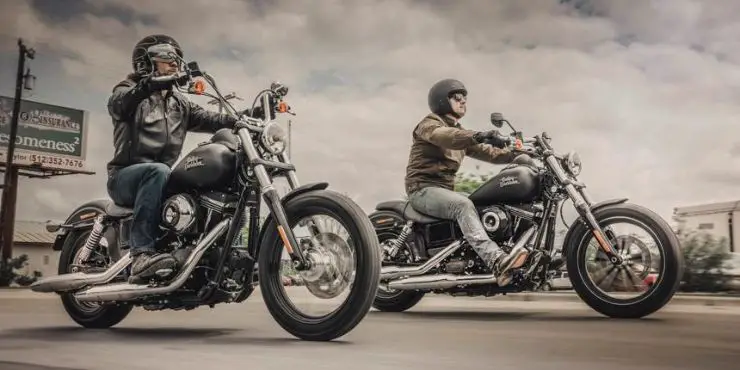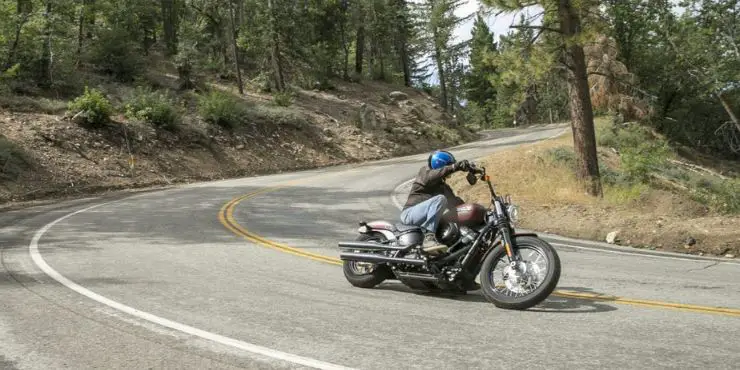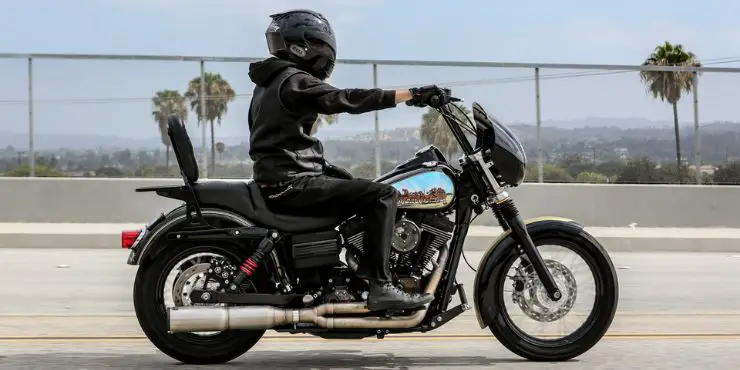Are you in the market for a new or second-hand Harley-Davidson Dyna bike but don’t know a lot about it? Don’t worry, by the time you’re done reading this article, you’ll know all about Harley-Davidson Dyna bikes.
“Dyna” refers to a line of Harley-Davidson motorcycles known for their rubber-mounted engines and exposed dual rear shock design, providing a balance between sportiness and touring comfort.
In this article, you’ll get to know all about Harley-Davidson Dyna bikes, what does Dyna mean, what made Dyna bikes so popular, why did Harley-Davidson stop manufacturing Dyna bikes, will Dyna bikes return in the future, and ten things you didn’t know about Harley-Davidson Dyna bikes. Stick around to get all the answers that you’re looking for.
What does Dyna mean?
The Harley-Davidson bike lineup constitutes five families of bikes – Touring (FLT), V-Rod (VRS), Softail (FLS), Sportster (XL), and Dyna (FXD). Touring bikes are the workhorse, V-Rod is the hooligan, Sportster is the little brother, and Softail is the pretty one. Dyna is seen as the middle child, often forced to struggle for attention but remarkable in its own way.
The distinguishing feature between the different Harley-Davidson families will be the frame. Harley-Davidson Dyna frames are formed using tubular steel. Similar to the Touring, Sportster, and V-Rod frames, they’re designed to accept twin external rear shocks and are attached to a double-sided swingarm. A Softail frame features a single, hidden rear shock, which gives the appearance of a rigid suspension.
The first Harley-Davidson Dyna was the 1991 FXDB Sturgis. It was a limited production model for commemorating the Sturgis Rally and Races. The Dyna chassis ended up being stiffer and much better suited to the Evolution engine than the outgoing FXR chassis. By 1995, the Dyna family had successfully replaced the FXR in the company’s lineup. Harley-Davidson continued developing and improving its bikes and in 2006, the Dyna family received a new chassis. In 2007, the Evo in the Dyna chassis got replaced by the Twin Cam engine, and it’s still used today.
As the middle child, Dyna bikes are bigger than the Sportster, but they aren’t as huge as the Touring bikes. With a wide variety of front ends available, the Dyna bikes have transformed from the Beach Cruiser to the Street Fighter to the Sports Tourist. With the addition of the Switchback, the Dynas are believed to be the Swiss Army Knife of the Harley-Davidson bike. These bikes are capable of boulevard posing and long-distance comfort with quick-release components.

The current lineup of Dyna bikes consists of the Street Bob, the Wide Glide, the Super Glide Custom, the Fat Bob, and the Switchback. The Street Bob is a part of the H-D1 Customization program launched in 2013. It means that the buyers will be able to custom order their Street Bob bikes with a variety of components installed at the factory. There is even e a 110th Anniversary Edition of the Super Glide Custom available too. It will definitely be a great collectible bike, as most Anniversary Editions have been in the past. The Dyna chassis is a sound basis for a great, honest motorcycle. It is ideally suited for riders who want to get the most out of their motorcycles. Shorter riders will have the option to lower the Dyna by getting shorter shocks installed. Meanwhile, taller riders can easily install forward controls and get more legroom. The chassis’ geometry will respond well to beach bars or ape hangers. You’ll be able to customize your Dyna with a variety of accessories and custom parts from their catalog, or head over to the aftermarket for specialty parts. The Dyna makes for a great canvas to showcase your creativity, and it’s a relative bargain in the Harley-Davidson lineup.
Why did Harley-Davidson stop manufacturing Dyna bikes?
Jaws dropped all over the world when Harley-Davidson enthusiasts heard that there wouldn’t be any more Dyna bikes. It came as a huge shock when people heard that this legendary lineup would no longer be in production. The Dyna bikes were bigger and beefier than Sportster bikes. However, they were more nimble and less expensive compared to touring bikes. Dyna bikes had the classic lines that most riders crave and the sound isn’t so bad either.
So, why did Harley-Davidson stop producing Dyna? Did Dyna bike suddenly become unprofitable or unpopular? Were Dyna bikes no longer in demand? The answer to both of these questions is a resounding no.
The Dyna frame featured a rubber-mounted, non-counter-balanced engine having twin external rear shocks. Harley-Davidson research team found out that people preferred the improved performance that the company offered with the Milwaukee-Eight engines’ twin counterbalanced and solidly mounted in the Softail lineup. They’re new and very different, and everyone loves them.
What made Harley-Davidson Dyna bikes so popular?
Harley-Davidson put together the Big Twin chassis and Sportster front end to create an extremely versatile bike. Many people refer to Dyna as Harley-Davidson’s middle child. While these bikes have never starved exceedingly for attention, these bikes have often been in the spotlight. Dyna can be pretty much everything Harley-Davidson riders want it to be – from a cruiser to a street bike to a touring ride. Harley-Davidson created a huge range of accessories and parts, so riders got endless combinations to choose from.
The engine vibration from the lineup’s rubber soul went a long way in making the riders happy. Some of them even stated that they were among the best handling Harley-Davidson bikes. The Dyna nameplate generally included the following –
- Limited Edition FXDB Daytona
- FXDB Sturgis Model
- FXDC Dyna Glide Custom
- FXD Dyna Super Glide
- FXDL Dyna Low Rider
- FXDX Super Glide Support
- FXDWG Dyna Wide Glide
- FXDBI Street Bob
- FXDS-Conv Dyna Glide Convertible
- FXDF Fat Bob
- FXDI35 35th Anniversary Super Glide
Will it be hard to find parts for your Dyna bikes in the future?
There’s a massive number of high-performance Dyna builds, so it’s reasonable to worry about the availability of parts. However, the answer is that you won’t find it hard to find Dyna bike parts any time soon.
Harley-Davidson produced the first official Dyna, the FXDB Sturgis in 1991. The company continued manufacturing the bikes until their 2018 lineup and replaced the Dyna lineup with the Softail lineup. That’s over two decades’ worth of Harley-Davidson bikes. If you love your Dyna bikes, you won’t have trouble maintaining your bike collection. Currently, there are several reliable online sources for used Harley-Davidson Dyna parts, custom parts, and aftermarket parts for Dyna.
Will Harley-Davidson Dyna bikes ever make a return in the future?
A common question that Harley-Davidson fans have regarding Dyna bikes is that will they make a comeback in the future. Harley-Davidson’s executives haven’t dropped any hints or made any official statements regarding this. Some members of the Softail family bear Dyna names recently. Low Rider, Street Bob, and Fat Bob may have the same moniker, but they’re different bikes. Softails feature a hard-mounted frame that’s stiffer and lighter, with a single mono shock hidden for simulating hardtail looks.

10 things that you probably don’t know about the Harley-Davidson Dyna
The Harley-Davidson Dyna lineup was famous even before it got featured on the hit TV series “Sons of Anarchy”. The chassis for the lineup was introduced first in 1991. It came with a wide variety of models with Harley-Davidson’s characteristic continual improvement schedule. Even if you are familiar with the amazing Dyna, then there are certain things that you might not know about.
1. The name Dyna has a real meaning
Harley-Davidson doesn’t choose any random names for their new models out of thin air. There’s always a value to the name and significant meaning. The word Dyna essentially means power. When you place this word in front of any other word, it’ll imply the addition of power. This was probably the intention behind the name that got distinguished down the line. It was all about adding extra power, and the name has a psychological effect, hinting at the thing that makes it special.
2. Engineers actually made an error of judgment on the first Dyna model
In 1991, when Dyna design first came up, the intention was to replace the FXR chassis, and it got accomplished through the Dyna chassis. The first model in the lineup was the FXDB Sturgis, which was only a limited production. The design team actually had to make a change to the engine mounting system and altered the 3 rubber mounts, reducing them to only 2. It caused less vibration control, which wasn’t really the best possible solution. However, it did make the production line assembly go much faster.
3. Dyna is widely considered to be Harley’s middle child
In families, there are younger brothers/sisters and elder brothers/sisters, but the one in the middle is the one who gets less attention compared to the other two. This happens to be a particular characteristic of the Dyna bikes. These bikes didn’t get quite as much attention as the larger touring bikes or as the smaller Sportsters. It even shares the size differential, landing right between the two. However, Dyna still managed to attract a niche audience of Harley-Davidson riders who weren’t shy about their love and preference for the Dyna lineup.
4. Dyna bikes can be customized for both short and tall bikers
One particular attraction of the Dyna lineup was that seasoned Harley-Davidson riders knew that the bike wasn’t difficult to customize. The riders were able to customize and adjust to accommodate excessive height or a lack thereof. The taller ones could alter the bike by installing forward controls that granted additional leg room. Meanwhile, the shorter ones achieved the needed lowering of the bike by making use of shorter shocks.
5. Dyna was distinguished from the others
Even though the Dyna didn’t always receive the same level of attention as other bikes in the Harley-Davidson families, it was remarkable and distinct. The important feature that separated the Dyna lineup from others was the frame design. These models all shared a common frame made using tubular steel.
6. Dyna bikes were the replacement for the FXR
When the Dyna bike was the new kid on the block, it took over the mantle from the outgoing FXR family. The new chassis was comparatively stiffer than the FXR. Meanwhile, the new design was requisite enough to hold the new Evolution engine while following the pattern of excellence that the brand had established.
7. Harley-Davidson decided to ditch the Dyna family
When the new Softail lineup was released in 2018, there was just one family missing. Harley-Davidson decided to discontinue the Dyna lineup in 2018. This decision was made in favor of motorcycles that featured easier handling, lighter weight, and faster acceleration.
8. Many bikers were ticked that the Dyna lineup was discontinued
The Dyna lineup was a lineup that had special meaning for plenty of Harley-Davidson riders. From the time these bikes were released, they managed to create a nostalgic glance back to the Super Glides of the 1970s and 1980s. This was a model that most riders loved and appreciated. Where would they even find another middle child who matches perfectly their demand for the ideal fit and size? They cannot because there isn’t one, and this is a big enough reason to be ticked by this decision.
9. Most Harley-Davidson purists felt insulted by the Dyna’s departure
The common argument posted to the Harley-Davidson purists who disagree with the decision to discontinue this lineup is that it became difficult to tell a Softail from a Dyna. Therein lied the entire problem. The differences were invisible only to the untrained eye. However, expert and proficient Harley-Davidson enthusiasts understood the differences and were big enough to matter to them. These folks know their stuff. Many of them demand bikes that cater to their preferences, and Dyna was a lineup that did just that.
10. There might be a silver lining for the Dyna lineup
There’s always a possibility that Harley-Davidson could bring back the Dyna if they get strong enough feedback from the customers. However, even if they do, the Dyna lineup might only be collector’s pieces. Even though there aren’t any new Dyna models coming out in the near future, there are still many Dyna bikes still going around. If you want to get your hands on a Dyna bad enough, you can look for a second-hand model. Vintage bikes do have their own special appeal too. The fuss being raised over discontinuing a lineup speaks well of the Dyna lineup. Meanwhile, it also sheds light on the success that Harley-Davidson experienced through creating a family of bikes that customers appreciated.
Conclusion
Thank you for reading. Hopefully, now you know a lot more about Harley-Davidson Dyna bikes, what does Dyna mean, what made Dyna bikes so popular, why did Harley-Davidson stop manufacturing Dyna bikes, will Dyna bikes return in the future, and ten things you didn’t know about Harley-Davidson Dyna bikes. Dyna means a family of Harley-Davidson, and it’s a truly remarkable lineup. The Dyna bike frames are made using tubular steel while they have a firm chassis. The current lineup of Dyna models consists of the Fat Bob, the Street Bob, the Wild Glide, the Super Glide Custom, and the Switchback.

